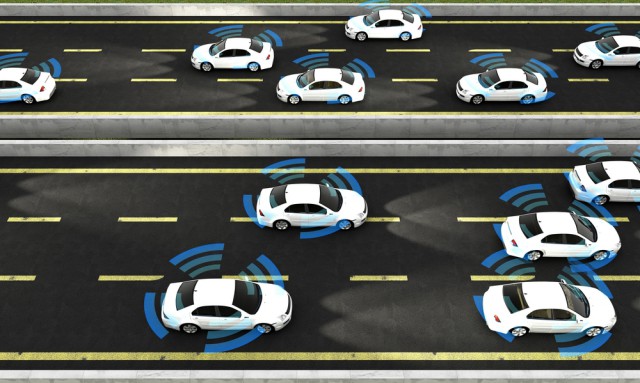Autonomous cars: A delicate balancing act of tech innovation, safety and security

Two big things happened on Wednesday, September 13. First, the House Energy and Commerce Committee unanimously passed the SELF Drive Act. Second, executives from BlackBerry, Cisco Jasper and AIMOTIVE took the stage at Mobile World Congress Americas to discuss autonomous cars and vehicles as a service.
In the Mobile World Congress Americas session, Barbara Peng, VP of Research for BI Intelligence, started off by asking each of the panelists for their predictions when autonomous cars would be on the road. Not one of the panelists gave an estimate, much to Barbara Peng’s frustration. But this just shows that even the people working to make driverless cars a reality knows there is too much work left to be done before they can estimate when they’ll be on the road.
Now when you talk about autonomous vehicles, what does that really mean? Alex Manea from BlackBerry helped clarify this for the audience at MWC Americas. He defined these types of vehicles as those without any steering wheel, accelerator pedal and brakes. He proclaimed that it’s where we’re headed as a society, which values and prioritizes the use of technology to innovate and improve the user experience. But while he couldn't give an exact estimate of when it would happen, he was adamant that it was still a long way off; 15-20 years away, as he put it. Why won’t it be a reality sooner? In Manea’s words, "we have to be comfortable giving up complete control and safety."
While connectivity and convenience are clearly huge benefits of being able to get in a car without having to actually drive it manually, it’s not enough. According to Junting Zhao from AIMOTIVE, "Consumers want to know the car is safe. The driverless car should know its immediate surroundings and plan ahead -- making the person feel more secure. And if something goes wrong, the driverless car should be able to call in and get help."
As someone who’s been working in the data security space for two decades, I can say that regulation will also be an important aspect, which brings me back to the second important thing that happened on September 13 -- the passing of the SELF Drive Act. The bill makes it easier for the National Highway Traffic Safety Administration to regulate what a self-driving car will look like and to grant permits for self-driving cars to hit the road for testing. And we know it will take a lot of tests -- somewhere in the millions of miles -- before autonomous cars will be a common sight on roads around the world.
Now I can’t talk about self-driving cars without recounting the fatal Tesla self-driving car accident that happened back in 2016. The Tesla Model S crashed into a truck that was turning left in front of it. The driverless car then ran off the road, hit a fence and power pole before it finally came to a stop. The end result: 40-year-old Joshua Brown was killed. During the MWCA panel session, James Dawson from Cisco Jasper said one of the big issues in this incident is that the driver was operating the vehicle outside of its performance characteristics. That put a lot of the burden on the driver. In this type of driverless car, which uses a computer vision-based vehicle detection system, the car isn’t intended to be used hands-free and parts of the system are unfinished. As James Dawson explained, "the driver is therefore responsible for paying attention to what’s going on around him." I don’t think this has anything to do with placing blame on the driver and being insensitive. It’s a simple fact based on the type of technology that’s currently available. It’s not at the level of fully autonomous.
When it comes to car accidents as a whole, they are usually handled by insurance companies or the matter goes to court when it can’t be resolved. As BlackBerry’s Alex Manea explained, "Usually, it’s a ‘he said, she said’ scenario. But with autonomous vehicles, the car will have all of the data about what actually happened, such as how fast the other driver was going and who was at fault. In the future, the autonomous vehicle will have the advantage and it will be a ‘he said, she can prove’ scenario."
The ability to collect and store all of this telling data will be important. But the question I would ask to the car brands and OEMs who provide driverless cars is this: What happens when it’s time to resell the car or return it to the manufacturer at the end of the lease period? Does all of that data get erased -- and is it erased permanently? How do we know if it’s been erased and can’t be hacked by cyber criminals? The SELF Drive Act addresses the need for cyber security and requires OEMs to take precautions regarding vulnerable systems. It even has a section on privacy that talks about data minimization. But it neglects to mention data retention periods or impose any requirement to erase data when it is no longer required. Perhaps this will be addressed in Committee.
Of course, there will inevitably be people who are slow to adapt to autonomous driving technology because they don't trust it. But there will also be people who are too fast to adopt driverless technology because they take progress for granted. That’s just as dangerous.
 Richard Stiennon is Chief Strategy Officer, Blancco Technology Group. He is responsible for leading the company’s overall corporate strategy, including long-term strategic planning, product positioning, public affairs, analyst relations, joint ventures and industry partnerships.
Richard Stiennon is Chief Strategy Officer, Blancco Technology Group. He is responsible for leading the company’s overall corporate strategy, including long-term strategic planning, product positioning, public affairs, analyst relations, joint ventures and industry partnerships.
